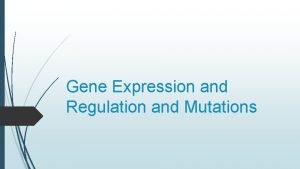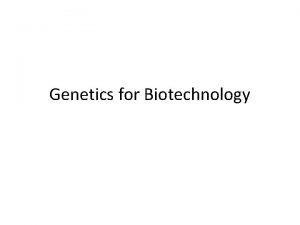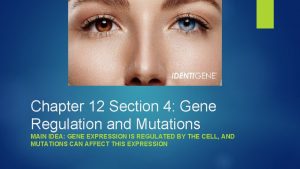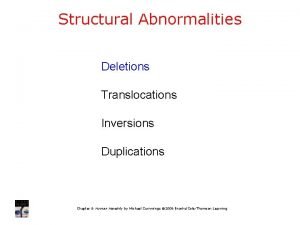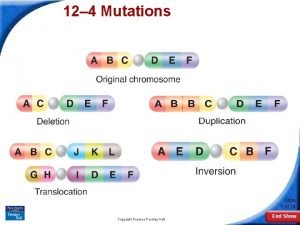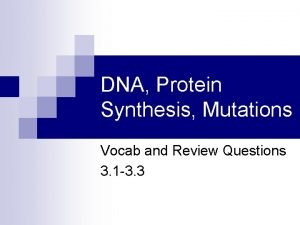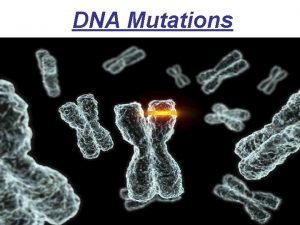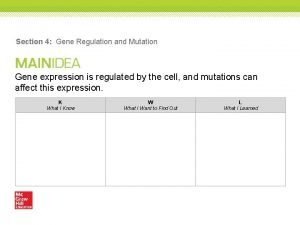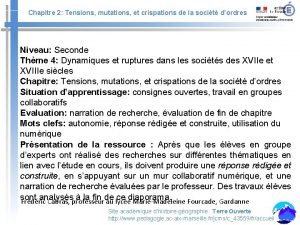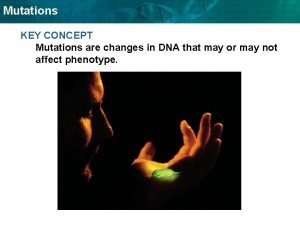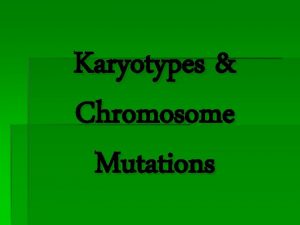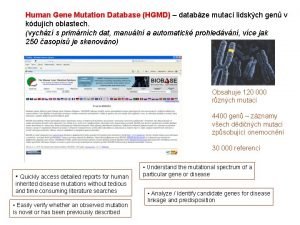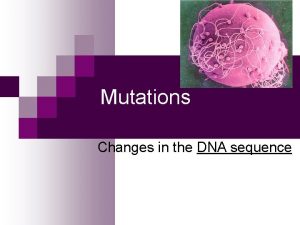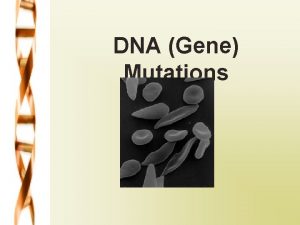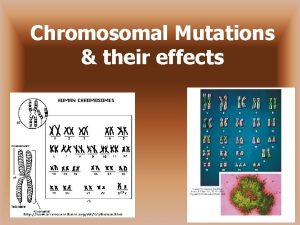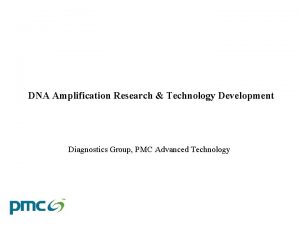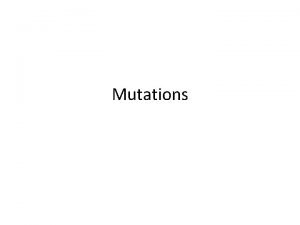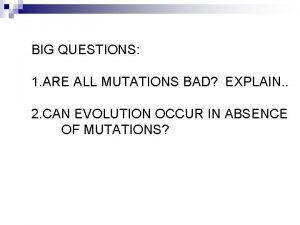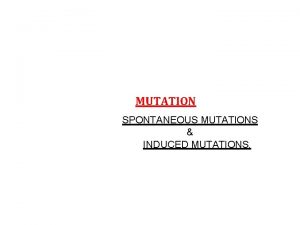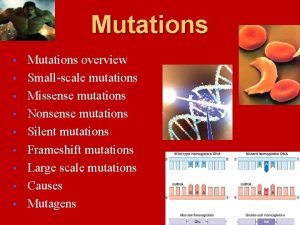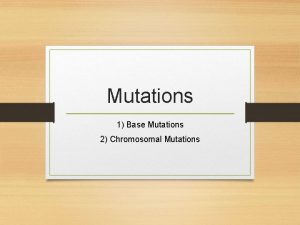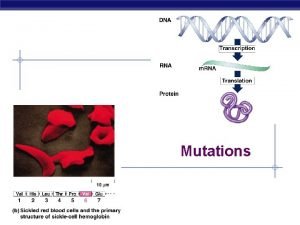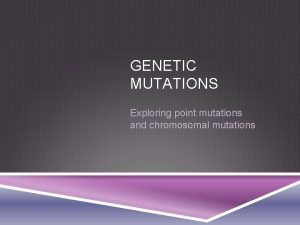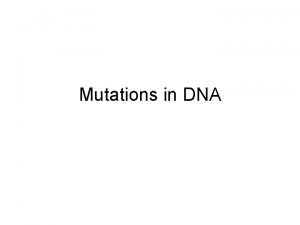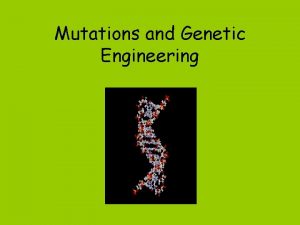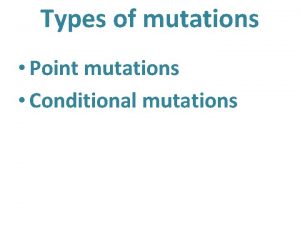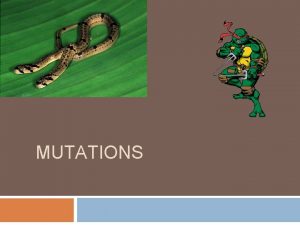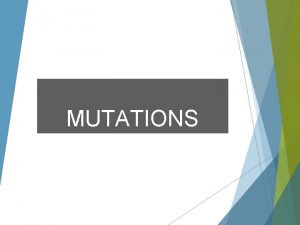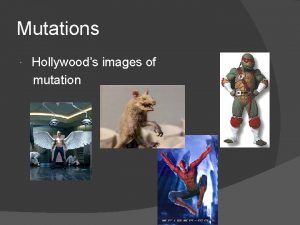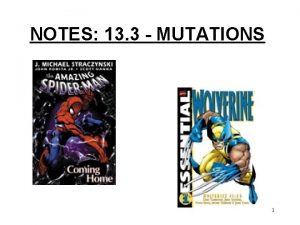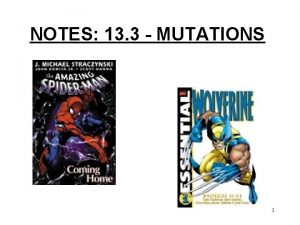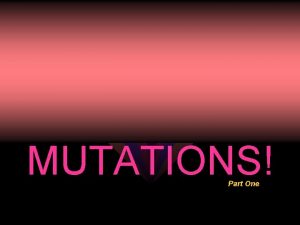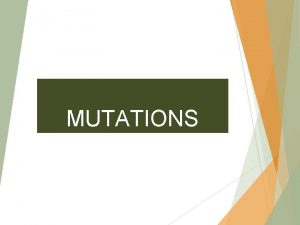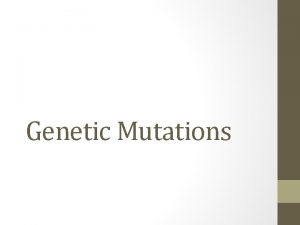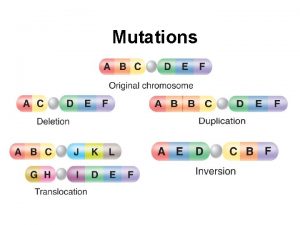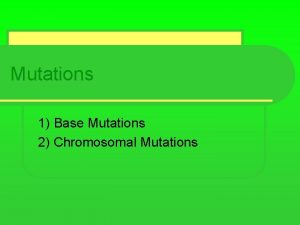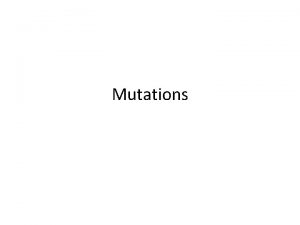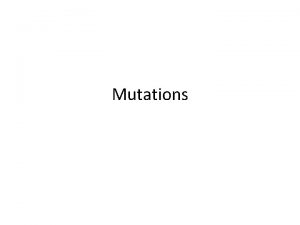12 4 Mutations 12 4 Mutations Slide 1
























- Slides: 24

12– 4 Mutations 12 -4 Mutations Slide 1 of 24 Copyright Pearson Prentice Hall End Show

12– 4 Mutations 12 -4 Mutations are changes in the genetic material. Slide 2 of 24 Copyright Pearson Prentice Hall End Show

12– 4 Mutations Kinds of Mutations that produce changes in a single gene are known as gene mutations. Mutations that produce changes in whole chromosomes are known as chromosomal mutations. Slide 3 of 24 Copyright Pearson Prentice Hall End Show

12– 4 Mutations Kinds of Mutations Gene Mutations • A mutation is a change in an organism’s DNA. Many kinds of mutations can occur, especially during replication. • Point mutations occur at a single point in the DNA sequence and include: 1. Substitution 2. Deletion 3. Insertion Slide 4 of 24 Copyright Pearson Prentice Hall End Show

12– 4 Mutations • A substitution mutation replaces one nucleotide for another. Substitutions usually affect no more than a single amino acid. Slide 5 of 24 End Show

12– 4 Mutations Kinds of Mutations • The effects of insertions or deletions are more dramatic. • The addition or deletion of a nucleotide causes a shift in the grouping of codons, therefore, these mutations are also called frameshift mutations. Slide 6 of 24 Copyright Pearson Prentice Hall End Show

12– 4 Mutations Kinds of Mutations In an insertion, an extra base is inserted into a base sequence. This extra base causes the frame to be shifted. Slide 7 of 24 Copyright Pearson Prentice Hall End Show

12– 4 Mutations Kinds of Mutations In a deletion, the loss of a single base is deleted and the reading frame is shifted. Slide 8 of 24 Copyright Pearson Prentice Hall End Show

12– 4 Mutations Kinds of Mutations Chromosomal mutations involve changes in the number or structure of chromosomes. Chromosomal mutations include deletions, duplications, inversions, and translocations. Slide 9 of 24 Copyright Pearson Prentice Hall End Show

12– 4 Mutations Kinds of Mutations Deletions involve the loss of all or part of a chromosome. Slide 10 of 24 Copyright Pearson Prentice Hall End Show

12– 4 Mutations Kinds of Mutations Duplications produce extra copies of parts of a chromosome. Slide 11 of 24 Copyright Pearson Prentice Hall End Show

12– 4 Mutations Kinds of Mutations Inversions reverse the direction of parts of chromosomes. Slide 12 of 24 Copyright Pearson Prentice Hall End Show

12– 4 Mutations Kinds of Mutations Translocations occurs when part of one chromosome breaks off and attaches to another. Slide 13 of 24 Copyright Pearson Prentice Hall End Show

12– 4 Mutations Significance of Mutations Many mutations have little or no effect on gene expression. If they have no effect, they are referred to as silent. • A point mutation may not change the amino acid that it is coded for. • Even if a change occurs, it may be not be significant enough to influence protein structure. Slide 14 of 24 Copyright Pearson Prentice Hall End Show

12– 4 Mutations Significance of Mutations Some mutations change phenotype and are the cause of genetic disorders. Potential impacts include: • A mutation may cause a premature stop codon. • A mutation may change protein shape or the active site. • A mutation may change gene regulation. • Polyploidy is the condition in which an organism has extra sets of chromosomes. Slide 15 of 24 Copyright Pearson Prentice Hall End Show

12– 4 Mutations Significance of Mutations • Mutations in body cells do not affect offspring. • Mutations in sex cells can be harmful or beneficial to offspring. • Natural selection often removes mutant alleles from a population when they are less adaptive. Slide 16 of 24 Copyright Pearson Prentice Hall End Show

Mutations can be caused by several factors. Replication errors can cause mutations. Mutagens, such as UV ray and chemicals, can cause mutations. Some cancer drugs use mutagenic properties to kill cancer cells. Slide 17 of 24 Copyright Pearson Prentice Hall End Show

12– 4 Click to Launch: Continue to: - or - Slide 18 of 24 End Show Copyright Pearson Prentice Hall

12– 4 A mutation in which all or part of a chromosome is lost is called a(an) a. duplication. b. deletion. c. inversion. d. point mutation. Slide 19 of 24 End Show Copyright Pearson Prentice Hall

12– 4 A mutation that affects every amino acid following an insertion or deletion is called a(an) a. frameshift mutation. b. point mutation. c. chromosomal mutation. d. inversion. Slide 20 of 24 End Show Copyright Pearson Prentice Hall

12– 4 A mutation in which a segment of a chromosome is repeated is called a(an) a. deletion. b. inversion. c. duplication. d. point mutation. Slide 21 of 24 End Show Copyright Pearson Prentice Hall

12– 4 The type of point mutation that usually affects only a single amino acid is called a. a deletion. b. a frameshift mutation. c. an insertion. d. a substitution. Slide 22 of 24 End Show Copyright Pearson Prentice Hall

12– 4 When two different chromosomes exchange some of their material, the mutation is called a(an) a. inversion. b. deletion. c. substitution. d. translocation. Slide 23 of 24 End Show Copyright Pearson Prentice Hall

END OF SECTION
 Heel and toe polka dance
Heel and toe polka dance How to facot
How to facot Chromosomal mutation
Chromosomal mutation Dna rna protein central dogma
Dna rna protein central dogma Chapter 12 section 4: gene regulation and mutations
Chapter 12 section 4: gene regulation and mutations Translocation mutation
Translocation mutation 12-4 mutations
12-4 mutations Missense mutation in sickle cell anemia
Missense mutation in sickle cell anemia Types of mutations
Types of mutations Cancer mutations
Cancer mutations Cytoplasm structure
Cytoplasm structure Protein synthesis and mutations
Protein synthesis and mutations Types of mutations
Types of mutations Section 4 gene regulation and mutations
Section 4 gene regulation and mutations Tensions mutations et crispations de la société d'ordres
Tensions mutations et crispations de la société d'ordres Gene mutations
Gene mutations Cancer mutations
Cancer mutations Karyotype mutations
Karyotype mutations Gene mutations
Gene mutations Dna types of mutations
Dna types of mutations What can cause mutations
What can cause mutations Chromosomal mutation
Chromosomal mutation Mutations in dna
Mutations in dna Chromosome mutation
Chromosome mutation Inversion dna
Inversion dna


